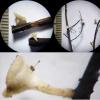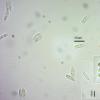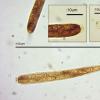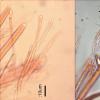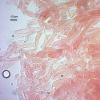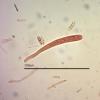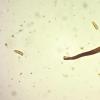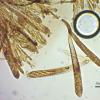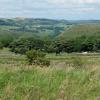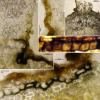
21-12-2025 09:32
Hello.A tiny ascomycete found embedded in wood in

21-12-2025 21:32
Pol DebaenstHello, Garden, Burgweg 19, Veurne, BelgiumOn 10/1

22-12-2025 23:38
Patrice TANCHAUDBonsoir, récolte sur un mur en pierre, apothéci

22-12-2025 00:47
Patrice TANCHAUDBonsoir, récolte à proximité du milieu dunaire

21-12-2025 21:40
Isabelle CharissouBonjour, j'aimerais connaitre les références de

20-12-2025 23:08
Patrice TANCHAUDBonsoir, récolte sur sol sablonneux dans l'arri�
Cudoniella clavus or Hymenoscyphus?
Steve Clements,
15-08-2016 21:00
Cet asco était sur des rameaux dans une zone humide. Il ressemble à un petit Cudoniella clavus, mais les spores ne sont pas tout à fait correct. Hymenoscyphus peut-être?
We found this stalked asco in some numbers on woody twigs in a wet area of mixed woodland. The apothecia were 1-2.5 mm in diameter, and the stalks 1-1.25 mm in length. The stem base was a little darker, but not blackened. Asci were dextinoid in Lugol, biseriate, approx 100 x10 um, without croziers, inoperculate and not blueing distinctly at the tips. It was hard to tell if the blueing was simply an artefact of the LED lighting of the microscope. Spores were dropped on a slide overnight, and were 14-17.5 x 5-5.5 in water, and 15-17 x 4-4.5 in Lugol. Mostly they contained 4 oil drops. Paraphyses were filiform, about 3 wide, septate, and with some branching. Subiculum from the outside edge of the cups was of long cells, varying from 2 to 10 um wide.
Cudoniella clavus is described in Fungi of Switzerland as having spores without drops, 9.5-15 long. Perhaps this is a Hymenoscyphus?
Cordialement,
Steve
Hans-Otto Baral,
15-08-2016 21:07

Re : Cudoniella clavus or Hymenoscyphus?
The substrate is veins from a leaf, and the fungus probably Hymenoscyphus fraxineus or albidus. Would be interesting to know whether the asci arise from croziers. typical is the blackened base.
Is there Fraxinus around? Which country is it from?
Is there Fraxinus around? Which country is it from?
Steve Clements,
15-08-2016 21:54
Hans-Otto Baral,
15-08-2016 22:02

Re : Cudoniella clavus or Hymenoscyphus?
yes, looks like without. I was thinking that the ash disease extended to whole England, making detection of H. albidus very difficult. Your sample was not rich?
Steve Clements,
15-08-2016 22:14
Re : Cudoniella clavus or Hymenoscyphus?
I have a couple of ascocarps remaining in the incubator. Is there anything else which I can look for microscopically?
Ash Dieback has not been found in our area yet. It would be a tragedy if it kills the ash trees which are very important as the Peak District National Park is very beautiful. Many of the trees in this picture are ash.
Steve
Ash Dieback has not been found in our area yet. It would be a tragedy if it kills the ash trees which are very important as the Peak District National Park is very beautiful. Many of the trees in this picture are ash.
Steve
Hans-Otto Baral,
15-08-2016 22:40
Steve Clements,
15-08-2016 23:27
Re : Cudoniella clavus or Hymenoscyphus?
Many thanks indeed,
Steve
Steve
